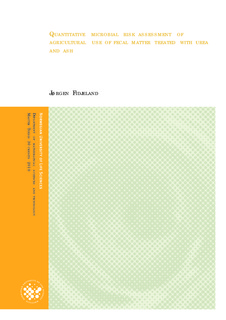Quantitative microbial risk assessment of agricultural use of fecal matter treated with urea and ash
Master thesis
Permanent lenke
http://hdl.handle.net/11250/188680Utgivelsesdato
2010-12-27Metadata
Vis full innførselSamlinger
- Master's theses (RealTek) [1722]
Sammendrag
Today about 2,6 billion people lack access to improved sanitation and over 2 billion people
use pit latrines. This results in spreading of pathogens from excreta into the environment
and drinking water sources, causing severe illnesses. In developing countries the health
impact of this is, however, overshadowed by malnutrition. Sustainable sanitation can
prevent spreading of pathogens to the environment, as well as ensure safe reuse of the
nutrients in excreta for food production in agriculture.
A planned sanitation system in Kampala, Uganda is aiming to sell fecal matter treated for
two months with urea, as a fertilizer product. Using urea, the most common mineral
fertilizer in the world, to treat fecal matter will inactivate most of the pathogens, and
increase the fertilizer value of the fertilizer product. Ash could also be used in combination
with urea to enhance the pathogen inactivation.
The objective of this research was to assess the health risk for the farmer applying the
fertilizer product, and for the food consumer eating crops grown in these fields. The
evaluation of the urea and ash treatment was conducted by using quantitative microbial risk
assessment for identifying the health risk, applying relevant data for the conditions in
Kampala.
Ascaris was identified as the main threat to human health. Assuming that the farmer is not
using protective clothing, 4 % w/w urea is needed to achieve an annual risk of Ascaris
infection less than 10-3, which is suggested to be tolerable. Health risk associated with
consuming raw carrots and spinach grown in soil amended with treated fecal matter were
acceptable if 3 % w/w urea or more was used in the treatment. Using ash in addition to urea
increased the Ascaris inactivation, but was not very favorable since water addition is needed
to maintain the moisture, extending the volumes needed during treatment.
An inactivation study of Salmonella typhimurium phage 28B in fecal matter treated with
urea and ash, showed no difference in inactivation at different pH levels. Because both
Salmonella typh. phage 28B and adenovirus are dsDNA viruses, raising the pH will probably
not affect the adenovirus inactivation either. However, a pH increase would increase the
rotavirus inactivation. More research is on their inactivation and fate in the soil is needed to
evaluate whether or not they represent a significant health risk in this context.
